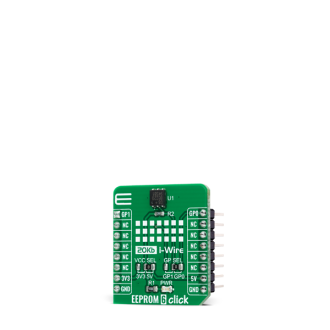
We strongly encourage users to use Package manager for sharing their code on Libstock website, because it boosts your efficiency and leaves the end user with no room for error. [more info]

Rating:
Author: MIKROE
Last Updated: 2020-10-14
Package Version: 1.0.0.0
mikroSDK Library: 1.0.0.0
Category: EEPROM
Downloaded: 3051 times
Not followed.
License: MIT license
EEPROM 6 Click is a compact add-on board that contains a serial EEPROM memory that operates from the 1-Wire interface. This board features the DS28EC20, a 20480-bit EEPROM organized as 80 memory pages of 256 bits each from Maxim Integrated.
Do you want to subscribe in order to receive notifications regarding "EEPROM 6 click" changes.
Do you want to unsubscribe in order to stop receiving notifications regarding "EEPROM 6 click" changes.
Do you want to report abuse regarding "EEPROM 6 click".


Library Description
The EEPROM 6 Click utilises the "One_Wire" Library for it's communications and functionalities.
Key functions:
void eeprom6_one_wire_init ( ) - Function initialises one wire communication.void eeprom6_read_mem ( uint16_t reg_adr, uint16_t n_len ) - The Read Memory function allows data to be sequentially read starting at an initial address.uint8_t eeprom6_write_mem ( uint16_t reg_adr, uint16_t n_len ) - The Write Memory function allows data bytes to be written sequentially.Examples description
The application is composed of three sections :
void application_task ( )
{
mikrobus_logWrite( "Writing : ", _LOG_TEXT );
mikrobus_logWrite( val_in, _LOG_TEXT );
eeprom6_write_mem( 0x0000, 9 );
Delay_ms( 100 );
mikrobus_logWrite( "Reading : ", _LOG_TEXT );
eeprom6_read_mem ( 0x0000, 9 );
mikrobus_logWrite( val_out, _LOG_TEXT );
mikrobus_logWrite( "-------------------", _LOG_LINE );
Delay_ms( 5000 );
}
Other mikroE Libraries used in the example:
The full application code, and ready to use projects can be found on our LibStock page.
Other mikroE Libraries used in the example:
Additional notes and informations
Depending on the development board you are using, you may need USB UART click, USB UART 2 click or RS232 click to connect to your PC, for development systems with no UART to USB interface available on the board. The terminal available in all MikroElektronika compilers, or any other terminal application of your choice, can be used to read the message.